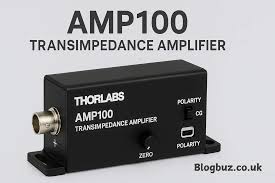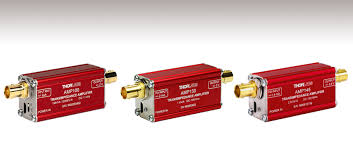The amp100 transimpedance amplifier is a powerful electronic device that helps change small electrical signals into stronger ones. Many people use the amp100 transimpedance amplifier in labs, cameras, and light sensors because it can read weak signals and make them easy to measure. It works by turning small electric currents into voltage, which is very useful in science and technology projects. If you are curious about how it works or what makes it special, this blog will help you understand everything in easy words.
The amp100 transimpedance amplifier is popular because of its high performance and accuracy. It helps in experiments where even the smallest light or signal needs to be detected clearly. This amplifier also supports low noise, meaning it gives clean results without extra unwanted signals. Many industries use it for testing, medical tools, and research work. In this post, we will explore how it works, its features, benefits, uses, and why engineers love it so much. If you want to learn about this amazing amplifier, you are in the right place!
Key Features That Make the AMP100 Transimpedance Amplifier Special
The amp100 transimpedance amplifier stands out because of its smart design and reliable performance. One of its best features is its low noise output. This means when it amplifies a weak signal, it does not add unwanted electrical noise, keeping the signal clean. It also has a high gain, meaning it can make small signals large enough to measure easily. Another great thing is its fast response time, which helps in applications where quick signal reading is needed.
The amp100 transimpedance amplifier is also very stable and does not overheat easily, even when used for a long time. It is built using high-quality materials that make it strong and long-lasting. It supports wide bandwidth, which means it can work with many different frequencies without losing signal quality. These features make it a reliable choice for people working in optical sensors, scientific labs, and industrial research projects. It is simple to connect, easy to use, and gives professional-level accuracy for a wide range of uses.
Why Engineers and Scientists Use the AMP100 Transimpedance Amplifier

Engineers and scientists prefer the amp100 transimpedance amplifier because it can handle very small signals that other amplifiers cannot process well. It helps in turning weak light or electrical signals into clear voltage readings, which are useful in testing and measurement systems. In labs, it is used for research that requires high sensitivity, like measuring the light intensity from lasers or photodiodes.
For engineers, this amplifier helps in product testing and sensor calibration. It ensures that signals are accurately measured, which improves the performance of the final product. The amp100 transimpedance amplifier is also used in fiber optics and biomedical devices because of its ability to work with very low signal levels. Many universities and industries use it for training and experiments because it offers both quality and reliability. It is an essential tool for anyone who needs precision and accuracy in signal amplification.
How the AMP100 Transimpedance Amplifier Converts Current Into Voltage
The working of the amp100 transimpedance amplifier is quite simple but smart. It uses an operational amplifier with a feedback resistor. The input current from a sensor enters the amplifier, and the feedback resistor helps convert that current into a voltage output. The voltage produced is proportional to the input current, meaning if the current increases, the voltage increases too.
This process allows small signals, like those from light detectors or sensors, to be read easily on devices like oscilloscopes or meters. The amplifier also controls the signal’s stability and speed, making sure the output is smooth and accurate. The amp100 transimpedance amplifier is designed to work with both fast and slow signal changes, so it is flexible for different types of experiments and measurements. This conversion process is the reason it is widely used in electronics, optics, and communication systems.
Best Applications of the AMP100 Transimpedance Amplifier in Real Life
The amp100 transimpedance amplifier is used in many fields, especially where precision is needed. In optical systems, it helps measure light from lasers, LEDs, or photodiodes. In research labs, it is used in experiments that study light intensity, radiation, or chemical reactions that produce tiny electrical currents.
In the medical field, it helps in devices that use light sensors, like heart rate monitors and imaging equipment. In industry, it helps test sensors and electronic devices to ensure they work correctly. In communication systems, it is used in fiber optics to read light signals accurately. The amp100 transimpedance amplifier is also popular among hobbyists who work on electronics projects because it is easy to set up and gives professional results. From science to engineering, this amplifier plays a key role in making sure signals are clear, accurate, and reliable.
Easy Guide to Setting Up Your AMP100 Transimpedance Amplifier
Setting up the amp100 transimpedance amplifier is quite simple, even for beginners. First, you need to connect the input signal, usually from a sensor or photodiode, to the input terminal of the amplifier. Then connect the output terminal to your measuring device, such as a voltmeter or oscilloscope. Make sure the power supply is stable and set according to the amplifier’s requirement.
Before using it, check all connections to ensure there are no loose wires. Once everything is connected, turn on the power and slowly adjust the gain or sensitivity if the amplifier allows it. This helps you control how much the signal is amplified. It is also important to keep the amplifier in a dry, cool place to avoid overheating. By following these simple steps, you can easily get clean and accurate readings from your amp100 transimpedance amplifier.
Common Problems and Fixes for the AMP100 Transimpedance Amplifier
Like any other electronic device, the amp100 transimpedance amplifier can sometimes show small problems. One common issue is signal noise or interference. This happens if the input wires are too long or near other electronic devices. To fix this, use short shielded cables and keep them away from strong electric fields. Another issue can be overheating if used for long hours without breaks. To prevent this, make sure there is proper airflow and avoid placing it in closed spaces.
Sometimes users may face low output signals. This usually happens if the input current is too small or the connections are not tight. Always check the input source and cables before using. If the amplifier is not responding at all, it may be due to a power issue, so check the power supply and connections carefully. Regular cleaning and careful use can help extend the life of the amp100 transimpedance amplifier and keep it performing at its best.
Comparing the AMP100 Transimpedance Amplifier With Other Amplifiers
The amp100 transimpedance amplifier is different from normal amplifiers because it is made for current-to-voltage conversion, not just voltage gain. Regular amplifiers increase the voltage of an input signal, but the amp100 takes current and changes it into voltage, making it perfect for sensors and light detectors.
Another key difference is its low noise level. Most amplifiers add extra noise when amplifying small signals, but the amp100 transimpedance amplifier keeps the signal clean. It is also designed for higher accuracy and faster response than standard amplifiers. While normal amplifiers are good for audio or power use, the amp100 is the better choice for precision experiments and optical measurements. This makes it more valuable in scientific, medical, and research work.
Maintenance Tips to Keep Your AMP100 Transimpedance Amplifier Working Well
Taking care of your amp100 transimpedance amplifier is simple but very important. Always keep it clean and free from dust. Dust can enter the small parts and affect performance. Keep the amplifier away from moisture and high heat because these can damage its internal circuits. When not in use, unplug it and cover it to protect it from dirt.
Check the cables and connectors regularly for any signs of wear or damage. Replace them if needed to avoid poor connections. Do not overload the amplifier with too high input current because it may harm the sensitive circuits inside. Following these small care tips will make your amp100 transimpedance amplifier last long and work smoothly without any problems.
Conclusion
The amp100 transimpedance amplifier is a simple but powerful device that plays a big role in many fields. It changes small current signals into voltage so that they can be measured, studied, and used in real-world applications. Its high accuracy, low noise, and fast response make it perfect for use in labs, industries, and research. Whether you are an engineer, student, or scientist, the amp100 transimpedance amplifier can help you understand and work with signals more easily. It is reliable, easy to use, and built for long-term performance.
FAQs
What is the main use of the amp100 transimpedance amplifier?
It is mainly used to convert small electric currents into voltage signals for measurement and analysis.
Can I use the amp100 transimpedance amplifier for optical sensors?
Yes, it is perfect for optical sensors, laser systems, and light detectors.
Why is the amp100 transimpedance amplifier better than normal amplifiers?
Because it gives high accuracy, low noise, and works well with very small signals.
